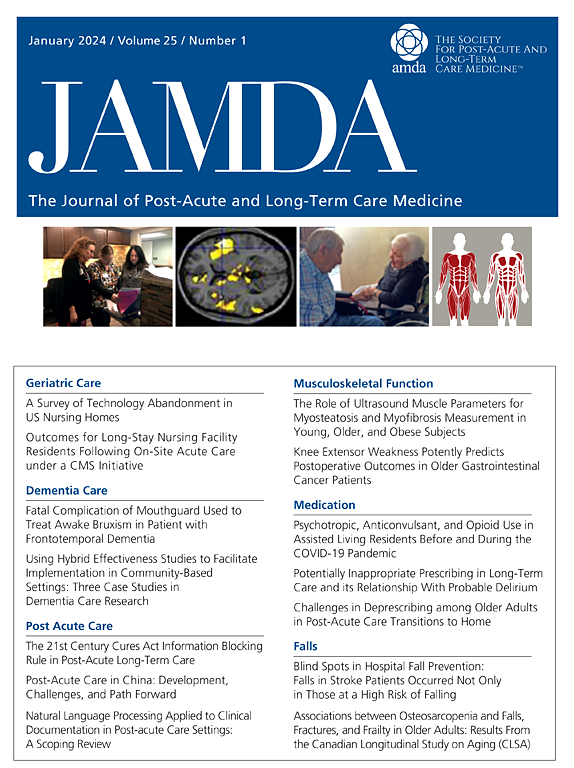弱势长期护理院住户的转院问题。
IF 4.2
2区 医学
Q2 GERIATRICS & GERONTOLOGY
Journal of the American Medical Directors Association
Pub Date : 2024-11-06
DOI:10.1016/j.jamda.2024.105348
引用次数: 0
摘要
研究目的确定患有智力和发育障碍(IDD)或严重精神疾病(SMI)和/或阿尔茨海默病及相关痴呆症(ADRD)的长期疗养院居民与未患有这些临床诊断的居民相比,从疗养院转移到疗养院的风险是否更高,并评估与整体转移和患有这些诊断的居民转移相关的因素:设计:对 2019 年养老院居民进行横断面队列研究:密歇根州长期疗养院居民,由最小数据集确定:将从疗养院转入疗养院的居民分为 5 组:IDD组、SMI和ADRD组、ADRD组、SMI组和所有其他组。我们检查了每个组别的转院率。我们评估了每组的转院几率,并对居民和疗养院特征、行为问题和临床指标进行了调整。我们使用分层逻辑回归法来确定每个组别中与转院相关的因素:在 37638 名长期疗养院居民中,有 2.3% 的人从疗养院转入疗养院。不同诊断组的转院率各不相同:IDD 为 1.9%,SMI 和 ADRD 为 2.8%,ADRD 为 1.9%,SMI 为 2.6%,所有其他为 2.5%。经过调整后,SMI 和 ADRD 组居民转院的可能性比所有其他组居民高 39%(调整后的几率比为 1.39;95% CI 为 1.14-1.68)。年龄≥75 岁、中重度认知障碍和跌倒与较低的转院几率有关。已婚和流浪与较高的转院几率有关。在每个组别中,与转院相关的因素各不相同:在密歇根州的长期疗养院居民中,与仅患有 SMI 或 ADRD 的居民相比,同时患有 SMI 和 ADRD 的居民与同时患有 IDD 且无上述诊断的居民相比,转院到另一家疗养院的风险最高。了解这一弱势群体转院的驱动因素值得进一步研究。本文章由计算机程序翻译,如有差异,请以英文原文为准。
Transfers among Vulnerable Long-Term Nursing Home Residents
Objectives
To determine whether the risk of nursing home-to-nursing home transfer is higher among long-term nursing home residents with intellectual and developmental disabilities (IDD), or serious mental illness (SMI), and/or Alzheimer's disease and related dementias (ADRD), relative to residents without these clinical diagnoses, and to assess the factors associated with transfer overall and for residents with these diagnoses.
Design
Cross-sectional cohort study of nursing home residents in 2019.
Setting and Participants
Michigan long-term nursing home residents identified from the Minimum Data Set.
Methods
Residents who had a nursing home-to-nursing home transfer were allocated into 5 groups: IDD, SMI and ADRD, ADRD, SMI, and all others. We examined transfer rates for each group. We assessed the odds of transfer for each group, adjusting for resident and nursing home characteristics, and behavioral issue and clinical indicators. We used stratified logistic regression to determine factors associated with transfers within each group.
Results
Among 37,638 long-term nursing home residents, 2.3% had a nursing home-to-nursing home transfer. Transfers varied across diagnosis groups: 1.9% in IDD, 2.8% in SMI and ADRD, 1.9% in ADRD, 2.6% in SMI, and 2.5% in all others. After adjustment, residents in the SMI and ADRD group were 39% more likely to transfer than those in the all others group (adjusted odds ratio, 1.39; 95% CI, 1.14–1.68). Aged ≥75 years, moderate to severe cognitive impairment, and falls were associated with a lower odds of transfer. Being married and wandering were associated with a higher odds of transfer. Factors associated with transfers varied within each group.
Conclusions and Implications
Among Michigan long-term nursing home residents, residents with both SMI and ADRD are at the highest risk for transfer to another nursing home when compared with residents with SMI or ADRD alone and with IDD and none of these diagnoses. Understanding the drivers of transfer of this vulnerable group warrants further investigation.
求助全文
通过发布文献求助,成功后即可免费获取论文全文。
去求助
来源期刊
CiteScore
11.10
自引率
6.60%
发文量
472
审稿时长
44 days
期刊介绍:
JAMDA, the official journal of AMDA - The Society for Post-Acute and Long-Term Care Medicine, is a leading peer-reviewed publication that offers practical information and research geared towards healthcare professionals in the post-acute and long-term care fields. It is also a valuable resource for policy-makers, organizational leaders, educators, and advocates.
The journal provides essential information for various healthcare professionals such as medical directors, attending physicians, nurses, consultant pharmacists, geriatric psychiatrists, nurse practitioners, physician assistants, physical and occupational therapists, social workers, and others involved in providing, overseeing, and promoting quality

 求助内容:
求助内容: 应助结果提醒方式:
应助结果提醒方式:


